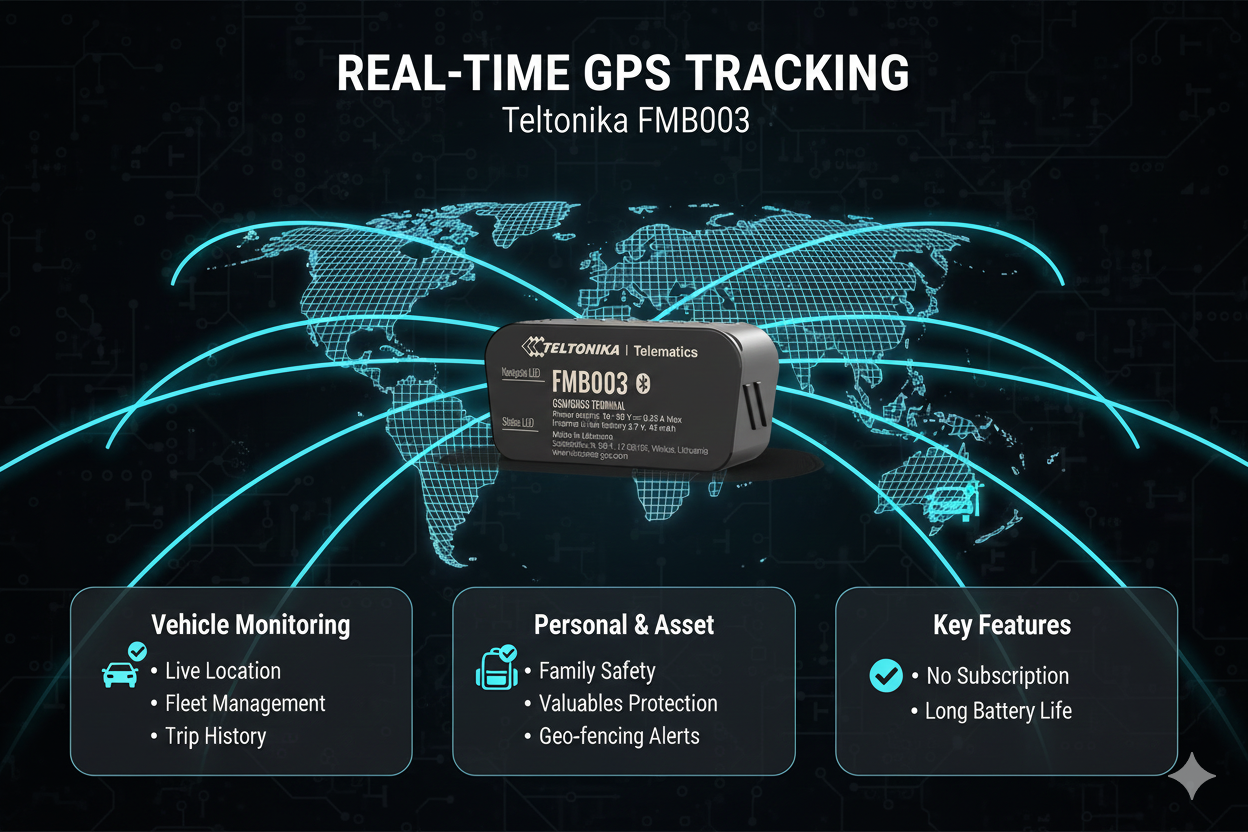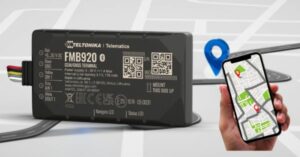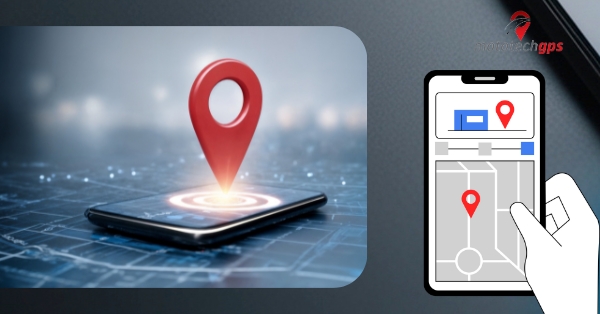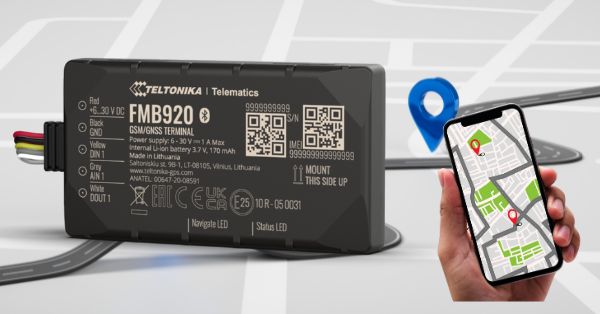Teltonika FMB003 GPS Tracker – Complete Guide: Features, Installation & Use Cases

The Teltonika FMB003 GPS tracker is one of the most compact and versatile OBD-plug-in GPS trackers available today. Designed specifically for cars, this mini tracker delivers real-time location tracking, OEM data reading (like fuel level and odometer), and a host of smart alert scenarios — all in a tiny “plug-and-track” footprint.

Teltonika FMB920
In this detailed guide, we’ll dive into:
-
What makes the FMB003 special
-
Its technical specifications
-
Installation process (plugging into OBD)
-
Key features such as crash detection, geofencing, driving behavior alerts, and fuel monitoring
-
How it communicates (GSM/GPRS, GNSS, Bluetooth)
-
Use cases for personal vehicles, fleet management, rental, insurance telematics, and more
-
Pros and cons
-
Troubleshooting common issues
-
Tips for maximizing performance
-
Recommended platforms/apps to pair with FMB003
Whether you’re a fleet operator in Canada, a car owner in Portugal, or a business in Bangladesh, this guide will help you decide if the FMB003 is the right tracker.
3. What Is the Teltonika FMB003?
The Teltonika FMB003 is a small, OBD-plug-in GPS tracker designed to be discreet, powerful, and efficient. Unlike larger trackers that require wiring, the FMB003 simply plugs into the OBD-II port of most cars, allowing you to read data from the vehicle’s ECU (Engine Control Unit). This enables advanced functionality such as real odometer reading, fuel level monitoring, and engine diagnostic parameters.
Its compact size (just 52.6 × 29.1 × 26 mm) makes it one of the smallest trackers in its class. Teltonika Telematics Wiki+1 The device also supports Bluetooth LE 4.0 for external sensors, giving you flexibility to expand its capabilities. Teltonika Telematics Wiki+1
4. Key Features of FMB003
Here are the most important and useful features of the FMB003:
-
Real-Time Tracking: Uses GNSS (GPS + GLONASS + Galileo + others) to provide accurate location data. Teltonika Telematics+1
-
OEM Parameter Reading: Through the OBD port, the device reads up to 32 parameters including real fuel level and odometer. Teltonika Telematics Wiki+1
-
Crash Detection: Built-in accelerometer detects collisions or sudden impacts. Teltonika Telematics Wiki
-
Geofence Alerts: Create virtual boundaries and get alerts when the vehicle enters or leaves these zones. RedGPS
-
Driving Behavior Scenarios: Alerts for speeding, excessive idling, towing, jamming, and unplugging. Teltonika Telematics+1
-
Sleep Modes: Supports multiple low-power modes (Online Deep Sleep, Deep Sleep, Ultra Deep Sleep) to save power when the vehicle is off. RedGPS+1
-
Bluetooth Low Energy (BLE): Compatible with BLE sensors (temperature, movement, etc.) and beacons for added data. Teltonika Telematics Wiki
-
Over-Voltage Protection: Works on 12–30 V DC input, protecting from voltage spikes. Teltonika Telematics Wiki
-
Firmware Updates: Support for FOTA (Firmware Over The Air) via Web, Bluetooth, or USB. Teltonika Telematics Wiki
-
Time Sync: Uses GNSS, NITZ (network), or NTP to keep time accurate. Teltonika Telematics Wiki
-
Small Backup Battery: Has a 45 mAh internal battery to keep the device running momentarily if vehicle power is lost. Teltonika Telematics Wiki
5. Technical Specifications
Here are the detailed specs for the FMB003:
| Specification | Value |
|---|---|
| Module Name | Teltonika TM2500 Teltonika Telematics Wiki+1 |
| GNSS Technology | GPS, GLONASS, Galileo, Beidou, SBAS, QZSS, DGPS, AGPS Teltonika Telematics |
| Receiver Channels | 33 tracking / 99 acquisition Teltonika Telematics |
| Sensitivity | −165 dBm Teltonika Telematics |
| Position Accuracy | < 2.5 m CEP Teltonika Telematics |
| Cellular | Quad-band 2G (850/900/1800/1900 MHz) Teltonika Telematics Wiki |
| Data Transfer | GPRS Multi-Slot Class 12 (up to ~240 kbps) Teltonika Telematics Wiki |
| Power Supply | 12–30 V DC, with over-voltage protection Teltonika Telematics Wiki |
| Backup Battery | 3.7 V, 45 mAh Li-Ion Teltonika Telematics Wiki |
| Operating Temperature | –40 °C to +85 °C Teltonika Telematics Wiki |
| Bluetooth | 4.0 + LE for external sensors Teltonika Telematics Wiki |
| OBD Interface | OBD II (supports CAN, K-line, etc.) teltonika.org+1 |
| Memory | 128MB internal flash for data storage teltonika.org |
| Physical Dimensions | 52.6 × 29.1 × 26 mm, Weight ~30 g Teltonika Telematics |
| IP Rating | IP41 Teltonika Telematics |
6. Installation Guide for FMB003
Installing the FMB003 is relatively simple, especially because it’s designed as a plug-and-play OBD tracker. Here are the steps:
-
Locate the OBD-II Port
Find your car’s OBD-II socket (usually under the dashboard near the steering wheel). -
Insert the FMB003
Plug the device directly into the OBD port. -
Ensure Power
The tracker draws power from the vehicle’s OBD supply (12–30V). Teltonika Telematics Wiki -
Activate SIM Card
Insert a Nano-SIM into the device. Ensure it has data + SMS enabled. -
Configure via Bluetooth or USB
Use Teltonika Configurator (via USB) or connect via Bluetooth LE to a phone, then configure APN settings and server parameters. Teltonika Telematics Wiki -
Set Up Alerts
Through the configuration app or web portal, define geofences, speed limits, crash detection, and other alert scenarios. -
Test the Setup
After configuration, drive a short distance to test live tracking, OBD data (speed, fuel, RPM), and that alerts are working correctly.
7. Use Cases & Applications
The FMB003 is ideal for a wide variety of use cases:
-
Fleet Management: Track cars in a light-commercial fleet, monitor driving behavior, fuel usage, and engine parameters.
-
Rental / Leasing: Rental companies can monitor mileage (odometer), fuel consumption, and detect abuse or misuse of vehicles.
-
Insurance Telematics (UBI): Insurance companies or users can collect driving data for usage-based insurance.
-
Car Sharing: Integrate into car-sharing services to monitor usage, location, and driving style.
-
Connected Car: Use Bluetooth LE sensors to extend functionality (temperature, door sensors, beacons).
-
Personal Vehicle Security: Car owners can benefit from alerts (crash, tow, unplug) and track their car live.
8. Pros & Cons
Pros:
-
Very small and discreet – easy to hide. Teltonika Telematics
-
Real OEM data: reads real fuel level and odometer. Teltonika Telematics Wiki
-
Advanced alerts: crash detection, geofence, over-speed, towing. Mirifica
-
Bluetooth LE support allows extra sensors. Teltonika Telematics Wiki
-
Low power consumption and multiple sleep modes. RedGPS
-
Firmware update over the air (FOTA), remote configuration. Teltonika Telematics Wiki
Cons:
-
Uses 2G network: may be deprecated or less reliable in some regions.
-
Very small backup battery (45 mAh) – not suitable for long offline tracking. Teltonika Telematics Wiki
-
Requires OBD-II port — not suitable for older vehicles or bikes without OBD.
-
IP41 rating: limited water resistance.
9. Troubleshooting & Tips for Teltonika FMB003 GPS tracker
Here are solutions to common issues and some best practices:
-
If the device is not connecting:
-
Check SIM card balance, APN settings, and SMS/data activation.
-
Verify that GPRS is configured correctly.
-
Use the Teltonika Configurator to send a “heartbeat” or diagnostic command.
-
-
If OBD data (fuel/odometer) is not being read:
-
Ensure car’s OBD protocol (CAN / K-Line) is supported.
-
Use official Teltonika supported-vehicle list to confirm which OEM PIDs are accessible. Teltonika Telematics Wiki
-
-
If alerts are not triggered:
-
Re-check your configuration for geofence or speed-limit scenarios.
-
Make sure accelerometer thresholds are set correctly for crash detection.
-
-
Power / Sleep Mode issues:
-
Confirm that the power supply voltage is stable (12–30V).
-
Select proper sleep mode to save battery when vehicle is idle (Ultra Deep Sleep recommended).
-
10. Recommended Tracking Platforms / Apps
You can use the FMB003 with different tracking platforms / mobile apps:
-
Teltonika FOTA Web: For remote device management, firmware updates, and configuration. Teltonika Telematics
-
Teltonika Configurator: Use via Bluetooth or USB to configure device settings. Teltonika Telematics Wiki
-
Third-party platforms: Many GPS tracking SaaS providers (fleet / IoT solutions) support FMB003. For example, Navixy supports this device. Navixy
11. Why Choose FMB003 Over Other Trackers?
-
Compact & Plug-and-Play: No complex wiring required; just plug into OBD.
-
Rich Telemetry: Unlike basic GPS trackers, it reads real vehicle data (fuel, odometer, RPM).
-
Scalability: Good for both personal and fleet use.
-
Low Power Draw: Very efficient; ideal for 24/7 tracking.
-
Bluetooth Connectivity: Expandable via sensors (temperature, movement).
-
Reliable Brand: Teltonika is a well-known, reputable brand in telematics.
12. Ideal Regions & Scenarios of Teltonika FMB003 GPS tracker
The FMB003 is especially useful in regions where 2G networks are still available or reliable. It’s a strong choice for:
-
Fleet operators in developing markets
-
Taxi / ride-share companies
-
Car rental services
-
Insurance tech (telematics) companies
-
Businesses or individuals needing discreet, reliable tracking
13. Conclusion
In summary, the Teltonika FMB003 GPS Tracker is a powerful, compact, and highly capable device built for modern connected-car applications. Its ability to read OEM data, track in real time, and support advanced alert scenarios makes it a top choice for personal vehicles, fleet managers, and telematics-based services.
While its reliance on 2G may be a drawback in some regions, for applications where compact size, plug-and-play installation, and rich data access are priorities — the FMB003 stands out as a compelling option.
If you’re looking for a tracker that balances price, size, and functionality, the FMB003 deserves serious consideration.



